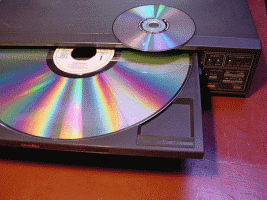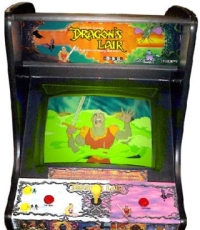
No doubt Part Two left you begging for more and to be honest
that's how my DOS cab left me. Don't get me wrong, it was amazing
to play all those classic games in that environment and it worked
brilliantly but I did just want a little bit more. I wanted a
newer version of M.A.M.E. because that would not only make it
compatible with newer games but it would also include bug fixes
for some of the older classics that I was already playing. In
addition to that though, I had to be able to play more than just
M.A.M.E. on it because my cab had a S.A.R. Factor (Spousal Approval
Rating) of 1. i.e. I would only get away with having one cab
in the house so it had to be a Jack of all trades, so what else
did I want to be able to do on it that would still sit happily
within the context of an arcade cab?
Laserdiscs?
Laserdiscs were the first commercial optical disc storage medium and they had great storage capacity. The discs were the size of a vinyl LP record but they looked like a CD with which they share similar technologies but which they predate by four years. The first Laserdisc title marketed in North America was the MCA DiscoVision release of the film Jaws in 1978, and the last two titles released in North America were Paramount's Sleepy Hollow and Bringing Out the Dead in 2000 but a dozen or so more titles continued to be released in Japan until the end of 2001. It was estimated that in 1998 laserdisc players were in approximately 2% of US households but they have now been all but eradicated by DVD players, a format which has itself been outdated to some degree by HD-DVD and Blu-Ray.
One interesting aspect of the Laserdisc, and one of the reasons that they were used inside Video Arcade machines, is not only the fact that they could store quite large amounts of video and audio data, (around 60 minutes on average), but that the discs were read optically by a laser which meant that there didn't need to be any physical contact between the player and the disc itself other than on the centre spindle around which the disc was spun. This meant that there would be less wear and tear and the system's life span was potentially much greater.
Laserdiscs?
Laserdiscs were the first commercial optical disc storage medium and they had great storage capacity. The discs were the size of a vinyl LP record but they looked like a CD with which they share similar technologies but which they predate by four years. The first Laserdisc title marketed in North America was the MCA DiscoVision release of the film Jaws in 1978, and the last two titles released in North America were Paramount's Sleepy Hollow and Bringing Out the Dead in 2000 but a dozen or so more titles continued to be released in Japan until the end of 2001. It was estimated that in 1998 laserdisc players were in approximately 2% of US households but they have now been all but eradicated by DVD players, a format which has itself been outdated to some degree by HD-DVD and Blu-Ray.
One interesting aspect of the Laserdisc, and one of the reasons that they were used inside Video Arcade machines, is not only the fact that they could store quite large amounts of video and audio data, (around 60 minutes on average), but that the discs were read optically by a laser which meant that there didn't need to be any physical contact between the player and the disc itself other than on the centre spindle around which the disc was spun. This meant that there would be less wear and tear and the system's life span was potentially much greater.

One of the first Laserdisc games released in 1983 was Dragon's
Lair from Cinematronics which starred an animated character
called Dirk The Daring, drawn by the former Disney animator
Don Bluth. Most other video games from this era represented
the characters as an object known as a sprite which
was then animated by displaying the same sprite but with subtle
differences such as the arms and legs in a slightly different place, much
like stop motion films do, but the quality of this kind of
animation was severely limited by the hardware limitations
of the day and the resolution and frame rate were restricted
as a result. Dragon's Lair took a different approach and showed
full video quality animation but with limited game play: i.e.
you watch a short clip of video and at the right moment press
the "sword" button to make Dirk swing his sword.
The Laserdisc would then jump to the appropriate "sword
swinging" video clip on the disc and play it, giving the
impression of one long video sequence controlled by the player.

The game caused such a sensation that the cabs would often
break due to excessive use, and Dragon's Lair was arguably
the most successful game on the laserdisc medium which
makes it aggressively sought after by collectors. Hardly
surprising then that it spawned a sequel and several imitations
too.
If like me you have never played Dragon's Lair in it's original form you are now unlikely to ever see it, so the next best thing you can hope for is to emulate it on your own cab using an emulator called Daphne.
For me that presented a slight problem in that Daphne does not run on DOS, or even Windows 98, it runs on Mac OS X, Linux or Windows XP, so the whole thing needed a rethink. The DOS machine I had in my cab just wasn't powerful enough to do what I wanted any more so it had to be replaced. I still have it because I know that the next time we have a party and people get to play the cab, one of them will want their own and I'll end up doing it for them and sticking that machine in it.
The last spare PC that I had was a P3 1.4GHz with 1GB of RAM and that would be powerful enough for me to do what I wanted, but I also needed a new Frontend because ArcadeOS would not run on XP and therefore would not launch Daphne ROMs.
I'll just mention Daphne ROMs quickly here as they are not subject to the same legal issues that I described in Part One for M.A.M.E. ROMs. Daphne ROMs are freely available for download and use for non-commercial purposes, and in fact once the emulator is installed it will help you to download them. The only proviso is that some of the games will only run if you own original discs for them in some form, and those games are Dragon's Lair, Dragon's Lair 2, Space Ace and Thayer's Quest, but more of that later when we get there.
Obviously the first thing I needed to do was to install the Operating System and all of the drivers then update and patch it using Window Update. I chose to use Windows XP Professional but there are certain tweaks that need to be applied to it. Fantastic Operating System that it is, it is weighed down with lots of services and processes that we simply don't need running in our cab, and anything we can do to reduce this number of background processes will improve not only its performance while running but also decrease its start up and shutdown times too. It will also help if you go into the BIOS settings and disable any hardware that you are not going to be using such as serial and parallel ports, integrated audio if you have a sound card and on board video if your motherboard has it. Though I won't be using the USB ports for controls, (I will be sticking with a PS/2 i-Pac cable), I left the USB ports enabled for a very good reason that I will come to later.
If like me you have never played Dragon's Lair in it's original form you are now unlikely to ever see it, so the next best thing you can hope for is to emulate it on your own cab using an emulator called Daphne.
For me that presented a slight problem in that Daphne does not run on DOS, or even Windows 98, it runs on Mac OS X, Linux or Windows XP, so the whole thing needed a rethink. The DOS machine I had in my cab just wasn't powerful enough to do what I wanted any more so it had to be replaced. I still have it because I know that the next time we have a party and people get to play the cab, one of them will want their own and I'll end up doing it for them and sticking that machine in it.
The last spare PC that I had was a P3 1.4GHz with 1GB of RAM and that would be powerful enough for me to do what I wanted, but I also needed a new Frontend because ArcadeOS would not run on XP and therefore would not launch Daphne ROMs.
I'll just mention Daphne ROMs quickly here as they are not subject to the same legal issues that I described in Part One for M.A.M.E. ROMs. Daphne ROMs are freely available for download and use for non-commercial purposes, and in fact once the emulator is installed it will help you to download them. The only proviso is that some of the games will only run if you own original discs for them in some form, and those games are Dragon's Lair, Dragon's Lair 2, Space Ace and Thayer's Quest, but more of that later when we get there.
Obviously the first thing I needed to do was to install the Operating System and all of the drivers then update and patch it using Window Update. I chose to use Windows XP Professional but there are certain tweaks that need to be applied to it. Fantastic Operating System that it is, it is weighed down with lots of services and processes that we simply don't need running in our cab, and anything we can do to reduce this number of background processes will improve not only its performance while running but also decrease its start up and shutdown times too. It will also help if you go into the BIOS settings and disable any hardware that you are not going to be using such as serial and parallel ports, integrated audio if you have a sound card and on board video if your motherboard has it. Though I won't be using the USB ports for controls, (I will be sticking with a PS/2 i-Pac cable), I left the USB ports enabled for a very good reason that I will come to later.
Copyright © JamesOnline.net. All rights reserved.